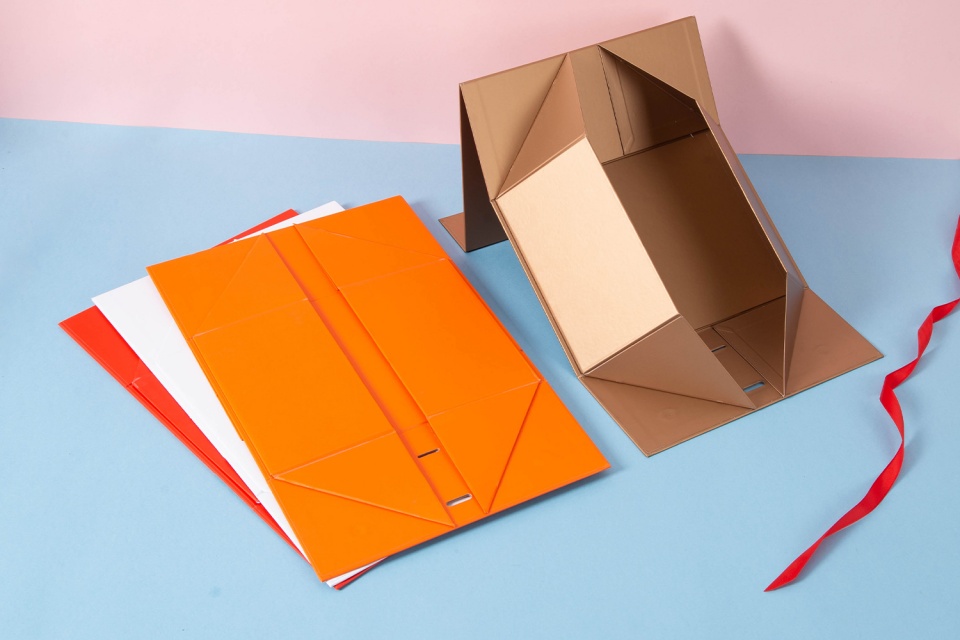Industry News
Cost Benefits Of Collapsible Packaging
Cost Benefits Of Collapsible Packaging
Summary
Collapsible packaging refers to innovative packaging solutions designed to optimize space and resource efficiency by allowing products to be folded or collapsed when not in use. This type of packaging is becoming increasingly notable across various industries, particularly in logistics, retail, and food services, due to its potential to significantly reduce shipping and storage costs while enhancing sustainability. The market for collapsible packaging is rapidly expanding, driven by rising consumer awareness of environmental issues and growing demand for efficient packaging alternatives that minimize waste and maximize space utilization.
The economic benefits of collapsible packaging are substantial, with estimates indicating that businesses can achieve a 20-30% reduction in transportation costs by optimizing space during shipping. Additionally, collapsible packaging helps companies save on storage costs by reducing the physical footprint required for inventory. The integration of advanced technologies, such as smart packaging and IoT applications, further enhances these economic advantages, allowing for better inventory management and operational efficiencies.
Environmental considerations play a crucial role in the adoption of collapsible packaging. Many of these solutions are designed with sustainability in mind, utilizing recyclable and biodegradable materials that help minimize the ecological footprint of packaging operations. The shift towards collapsible designs not only aids in waste reduction but also promotes resource conservation, thereby aligning with global trends towards sustainability and circular economies.
Despite the advantages, the transition to collapsible packaging faces challenges, including operational constraints in manufacturing and consumer acceptance issues due to perceived high upfront costs. Regulatory compliance also poses obstacles, as businesses must navigate various safety and environmental standards associated with packaging materials. Overall, the cost benefits of collapsible packaging, combined with its environmental advantages, position it as a transformative solution in the packaging industry, although ongoing challenges must be addressed to fully realize its potential.
Types of Collapsible Packaging
Collapsible Rigid Containers
Collapsible rigid containers are designed to combine the strength of traditional rigid boxes with the space-saving benefits of a collapsible design. Made from sturdy materials such as cardboard or plastic, these containers maintain their shape and provide robust protection for their contents. When not in use, they can be easily folded flat, allowing for reduced storage and transportation costs, which contributes to their growing popularity in various industries.
Material Variants
The most prevalent materials used for collapsible rigid containers are plastic and cardboard. The plastic segment holds a dominant share in the market, attributed to its corrosion resistance and mechanical strength. Plastic is lightweight and can be easily modified, making it a favorable choice for manufacturers, especially in industries like logistics and storage where space is limited. Meanwhile, cardboard containers are also gaining traction, as they are often made from recycled materials, thus promoting sustainability.
Folding Cartons
Folding cartons are another significant type of collapsible packaging. They are versatile and can be customized in various shapes and sizes to meet the needs of different industries. Their eye-catching designs not only enhance brand visibility but also encourage consumer engagement at the point of purchase. Folding cartons can be produced quickly and cost-effectively, primarily from paperboard, making them an attractive option for businesses seeking both quality and affordability.
Eco-Friendly Features
Both collapsible rigid containers and folding cartons have eco-friendly attributes. Many collapsible options are designed to be made from recyclable materials, thereby reducing the overall environmental impact. For example, folding cartons can be entirely paperboard-based, minimizing the use of plastics and aligning with the increasing demand for sustainable packaging solutions. This shift towards environmentally responsible materials reflects broader trends in the packaging industry, where companies prioritize sustainability while maintaining cost-effectiveness.
Economic Benefits
Collapsible packaging presents significant economic advantages for businesses, particularly in the realms of shipping costs and operational efficiency. One of the primary benefits of using folding boxes is their ability to optimize space utilization during transportation. By minimizing empty space in shipping containers, businesses can reduce the number of trips required, leading to a 20-30% reduction in transportation volumes and corresponding emissions. This space optimization is further enhanced by the lightweight nature of collapsible packaging, which can lower freight costs by 20-30%, especially given the dimensional weight pricing model employed by many carriers.
In addition to lowering shipping expenses, collapsible packaging also contributes to cost-effective storage solutions. The reduced storage footprint of folded boxes allows businesses to maximize existing warehouse capacity or potentially downsize their storage requirements, which translates into substantial savings on rent and utilities. Improved storage efficiency also minimizes the need for additional handling equipment and labor, streamlining operations and reducing overall overhead costs.
Furthermore, the integration of advanced technologies such as smart packaging and the Internet of Things (IoT) enhances logistics efficiency. Companies that adopt loT-enabled folding boxes can achieve operational cost savings of up to 20%, as these technologies facilitate real-time tracking and effective management of inventory and returns. As a result, businesses can respond swiftly to logistics challenges, ultimately enhancing customer satisfaction and reinforcing their commitment to sustainability.
Environmental Benefits
The environmental benefits of collapsible packaging are significant, particularly in the context of waste reduction and resource conservation. These packaging solutions are designed to minimize material usage, which can lead to a lower carbon footprint and reduced energy consumption throughout their life cycle. By using collapsible packaging, companies can decrease reliance on fossil fuels, as these materials often require less energy to produce compared to traditional packaging methods.
Waste Reduction
One of the primary advantages of collapsible packaging is its potential for waste reduction. Traditional packaging contributes substantially to municipal solid waste, with packaging and containers comprising a large portion of total waste generated. By adopting collapsible solutions, businesses can significantly lower the volume of waste sent to landfills. Moreover, recyclable and reusable materials help divert waste from disposal sites, promoting a circular economy where materials are continuously reused.
Resource Conservation
Collapsible packaging also plays a crucial role in conserving natural resources. By adopting sustainable materials—such as bioplastics, recycled plastics, and renewable resources like bamboo—companies can minimize their ecological footprint. The use of these materials helps preserve non-renewable resources and supports the conservation of ecosystems. Additionally, implementing a minimalist approach to packaging design reduces unnecessary components, further mitigating environmental impacts and enhancing the efficiency of resource use.
Economic and Consumer Benefits
The transition to collapsible packaging not only benefits the environment but also presents economic advantages for companies. Governments worldwide are increasingly offering incentives for businesses that adopt eco-friendly practices, creating a favorable financial landscape for sustainable packaging solutions. Furthermore, research indicates that consumers are more satisfied with environmentally friendly packaging, which can enhance brand loyalty and market competitiveness.
Case Studies
Overview of Implementations
Numerous companies have successfully implemented collapsible packaging solutions, demonstrating significant cost benefits and operational efficiencies. These case studies illustrate the diverse applications and outcomes of adopting innovative packaging strategies across different industries.
Omnichannel Retail Case Study
One notable case study involves an omnichannel retail company that operates hundreds of physical retail outlets alongside a growing e-commerce fulfillment network. The company aimed to assess the financial and environmental impact of integrating reusable packaging into its supply chain. By applying newly proposed metrics for supply chain circularity, the study calculated Total Logistics Costs under various operational scenarios, revealing that the costs associated with operating a circular supply chain with reusable packages could range from $2.8 million to $8.7 million over a 12-month period across 400 stores. The cost per order varied between $1.10 and $3.50 depending on the packaging used, underscoring the financial viability of reusable options in retail settings.
Glassware Manufacturer in India
In another example, a leading glassware manufacturing company in India sought to address a significant issue of product breakage during transit to e-commerce platforms. By implementing foam nets as void fills around each product, the company successfully minimized damage, thereby reducing the costs associated with returns and replacements. This strategic use of collapsible packaging not only safeguarded the products but also streamlined logistics, ultimately leading to increased margins and profitability.
Compliance and Market Growth
Companies adopting sustainable practices, such as the use of collapsible and eco-friendly packaging materials, have been observed to achieve up to 15% market growth. This trend is particularly evident in sectors responding to increasing regulations favoring sustainable materials. For instance, the use of folding boxes has been linked to enhanced compliance with sustainability regulations, reinforcing customer loyalty and improving market positioning for companies that prioritize these practices.
Food & Beverages Sector
The food and beverages industry has experienced significant growth due to an increase in packaged food consumption. This segment, being the largest in the packaging market, illustrates the critical role of collapsible packaging in meeting consumer demand for convenience. Companies in this sector are leveraging innovative packaging solutions to enhance product accessibility while minimizing waste, thereby capitalizing on the shifting consumer preferences for ready-to-eat and convenient food options. These case studies collectively highlight the transformative impact of collapsible packaging across various industries, offering insights into cost efficiencies, sustainability benefits, and market competitiveness.
Challenges and Considerations
Operational Constraints
Manufacturers face several operational challenges in the production of collapsible packaging, including the need for precise quality control and advanced machinery. The complex manufacturing processes required for collapsible tubes, in particular, necessitate ongoing investment in technology upgrades and staff training to maintain product integrity. Furthermore, the rigorous safety and hygiene regulations, especially in the pharmaceutical and food industries, complicate operational processes and increase costs.
Market Dynamics
The rapid and unpredictable shifts in demand have posed significant challenges for companies striving to optimize packaging solutions. This inefficiency can lead to higher operational costs and complicate logistics, ultimately affecting the overall sustainability of collapsible packaging initiatives. Manufacturers are compelled to innovate and adapt continuously to meet evolving consumer expectations while managing these pressures.
Consumer Adoption
Despite a growing trend towards sustainability, there remain obstacles to consumer adoption of collapsible packaging. Issues such as consumer awareness and acceptance, along with the perceived high upfront costs associated with transitioning to more sustainable options, can hinder market penetration. Additionally, consumer preferences continue to evolve, necessitating manufacturers to stay attuned to shifting attitudes towards sustainability and packaging solutions.
Regulatory and Compliance Challenges
Regulatory frameworks can complicate the implementation of collapsible packaging strategies. Compliance with local and international regulations, such as those outlined in Regulation (EU) No 1169/2011, is essential but can add layers of complexity to the design and production processes. Adhering to these regulations not only involves understanding graphic usage on packaging but also entails ensuring that all materials and designs meet specified safety and environmental standards.
Economic Viability
The initial costs associated with developing and implementing collapsible packaging solutions can be significant. Companies must carefully balance these costs against the potential long-term benefits, such as reduced material usage and lower freight costs, which can arise from more efficient packaging solutions. Achieving a favorable Production Efficiency Ratio, typically around 0.85 to 0.95, is crucial for ensuring the economic viability of collapsible packaging initiatives.
Future Trends
Sustainability and Environmental Impact
The packaging industry is increasingly focusing on sustainability as a key driver for future growth. As consumer priorities evolve, businesses are adopting innovative packaging solutions that minimize environmental impact. This includes the shift towards biodegradable and compostable materials, which aim to address the growing concerns regarding plastic waste and its effect on the environment. The sustainable packaging market is projected to grow significantly, from an estimated USD 292.71 billion in 2024 to USD 423.56 billion by 2029, reflecting a compound annual growth rate (CAGR) of 7.67%. This growth is largely attributed to rising consumer interest in sustainability and stricter regulations aimed at reducing packaging waste, particularly single-use plastics.
Innovations in Packaging Design
Future trends in packaging design are leaning towards functionality and efficiency. Innovations such as collapsible rigid containers are gaining popularity due to their space-saving features and aesthetic appeal. These containers can be easily folded flat when not in use, reducing storage space and transportation costs while maintaining a premium presentation for high-end products. As e-commerce continues to grow, the demand for packaging solutions that combine convenience with sustainability will drive further innovation in this area.
Regulatory Developments
As government regulations become more stringent, companies must adapt their packaging strategies to comply with evolving standards. The European Union's Circular Economy Action Plan and similar mandates in countries like the United States and Canada are compelling businesses to invest in sustainable packaging solutions. Companies that proactively navigate these regulatory developments will likely gain a competitive advantage, as they align their practices with consumer expectations and legal requirements.
Growth of Recycled Materials
The use of recycled materials in packaging is set to increase significantly. The market for recycled materials packaging solutions is projected to reach USD 245.56 billion by 2029, driven by the growing adoption of post-consumer recycled (PCR) materials. This shift not only reduces reliance on virgin materials but also promotes a circular economy by reintroducing used materials into the production cycle, thereby minimizing waste and optimizing manufacturing processes.
Energy Efficiency and Production Processes
Manufacturers are also exploring ways to enhance energy efficiency in packaging production. The transition to renewable energy sources, such as solar and wind, is becoming more prevalent, reducing the carbon footprint associated with packaging manufacturing. Furthermore, sustainable materials often require less energy to produce compared to traditional materials, further supporting sustainability goals while potentially lowering costs.
Categories
Latest News
Contact Us
Contact: Aaron Lee
Phone: +8613570866244
Tel: +8675529490260
Add: Li Songlang 2nd Industrial Zone,No.18,FengTang Rd,Guangming New District


